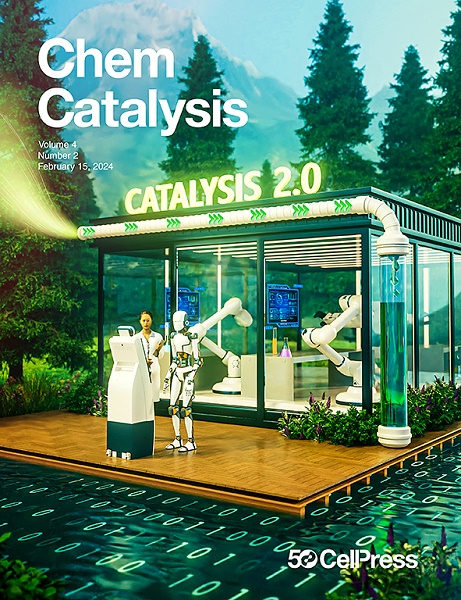Efficient urea photosynthesis via CuFe dual-atom synergistic catalysis
IF 11.6
Q1 CHEMISTRY, PHYSICAL
引用次数: 0
Abstract
Photocatalytic conversion of N2 and CO2 into urea is a highly desirable yet formidable challenge given the inherent inertness of N2/CO2 and poor C–N coupling activity. Herein, we introduce a Cu single-atom-decorated porous Fe2O3 nanorod (Cu-Fe2O3) photocatalyst with a Cu–O–Fe configuration for efficient photocatalytic N2/CO2 co-reduction to urea. Because the d-orbitals of the Cu/Fe sites are close to the molecular orbitals of CO2/N2, the CuFe dual active sites can selectively adsorb and activate N2/CO2, thereby facilitating efficient C–N coupling. The incorporation of the high-electrostatic-potential Cu creates a localized electrostatic-potential difference over Fe2O3, enabling the sequential activation of CO2 and N2. Consequently, Cu-Fe2O3 offers the highest urea activity (171 ± 12 μmol g−1 h−1) and selectivity (>90%) reported to date. This work showcases a promising avenue for green urea synthesis as well as the asymmetric coupling reaction.

通过CuFe双原子协同催化高效尿素光合作用
考虑到N2/CO2固有的惰性和较差的C-N偶联活性,光催化将N2和CO2转化为尿素是一个非常理想但艰巨的挑战。本文介绍了一种Cu- o- fe结构的单原子修饰多孔Fe2O3纳米棒(Cu-Fe2O3)光催化剂,用于光催化N2/CO2共还原制尿素。由于Cu/Fe位点的d轨道与CO2/N2的分子轨道接近,CuFe双活性位点可以选择性吸附和激活N2/CO2,从而促进高效的C-N耦合。高静电电位Cu的加入在Fe2O3上产生了局部的静电电位差,使CO2和N2的顺序活化成为可能。因此,Cu-Fe2O3具有迄今为止报道的最高尿素活性(171±12 μmol g−1 h−1)和选择性(>90%)。这项工作为绿色尿素合成和不对称偶联反应提供了一条有前途的途径。
本文章由计算机程序翻译,如有差异,请以英文原文为准。
求助全文
约1分钟内获得全文
求助全文
来源期刊
CiteScore
10.50
自引率
6.40%
发文量
0
期刊介绍:
Chem Catalysis is a monthly journal that publishes innovative research on fundamental and applied catalysis, providing a platform for researchers across chemistry, chemical engineering, and related fields. It serves as a premier resource for scientists and engineers in academia and industry, covering heterogeneous, homogeneous, and biocatalysis. Emphasizing transformative methods and technologies, the journal aims to advance understanding, introduce novel catalysts, and connect fundamental insights to real-world applications for societal benefit.

 求助内容:
求助内容: 应助结果提醒方式:
应助结果提醒方式:


